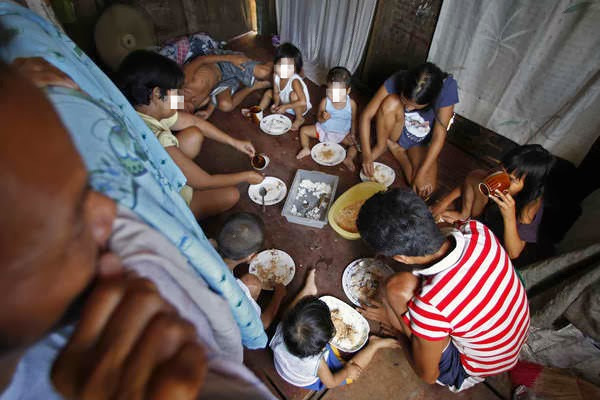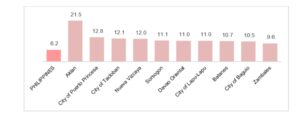After three decades of “steady progress” the Philippines still struggles to close one of the widest wealth gaps in East Asia, with the country ranking 15th out of 65 countries in terms of inequality, according to a study released by the World Bank.
In a report made by the Washington-based lender released on Tuesday titled; “Overcoming Poverty and Inequality in the Philippines: Past, Present, and Prospects for the Future,” it noted that while the Philippines made strides in poverty reduction, it still has among the highest inequality rates in East Asia.
Using the income Gini coefficient, a standard measure of income inequality from 0 to 1, with 0 representing total income equality; of 42.3% back in 2018, the country had one of the highest rates of income inequality in East Asia.
The World Bank said that PH poverty fell from 49.2% in 1985 to 16.7% in 2018 due to the increase of jobs outside agriculture. However by 2018, the middle class had expanded to nearly 12 million people and the economically secure population had risen to 44 million.
Now, the top 1% of earners combined captures 17% of the country’s national income, World Bank study found, with only a measly 14% being shared by the bottom 50%
Ndiamé Diop, World Bank Country Director for Brunei, Malaysia, Philippines, and Thailand in a press statement said that “The Philippines aims to become a middle-class society free of poverty by 2040, but we know from global experience that no country has managed to make this transition while maintaining high levels of inequality”.
Diop also said that “Inequality of opportunity and low mobility across generations wastes human potential and slowdown innovation, which is crucial for building a competitive and prosperous economy that will in turn improve the well-being and quality of life of all Filipinos”.
The World Bank explained that while the gap between top and bottom earners in the Philippines has lessened, it is still higher than in many of the country’s regional neighbors. Among East Asia Pacific countries whose data are available for 2014–19, only in Thailand is income inequality greater than in the Philippines.
Data from the World Inequality Database from 1980 to 2019, only Thailand’s top 1% had a greater share of the national income, though the Philippines notably ranked higher than China, Malaysia, and Indonesia in that metric heading into 2020.
But In terms of consumption inequality, the Philippines performed better globally, ranking 30th out of 72 countries. But except for Laos, it is still higher than East Asia Pacific countries.
During a virtual launch of the World Bank report, Nadia Belhaj Hassine Belghith, Senior Economist with the East Asia Poverty Global Practice covering Thailand and the Philippines who led the study, said that the Philippines actually achieved three decades of sustained decline in poverty and a decade of reduction in inequality starting from 1985, when poverty fell by two-thirds.
“In that period, the gradual shift of workers to more productive sectors with higher reliance on wage income was identified as among the drivers in the reduction of poverty at the time” Belghith said.
Unfortunately, factors like unequal opportunities, slow access to tertiary education among low-income households, inequality in returns to college education, and social norms putting the heavier burden of childcare on women has slowed down the thinning inequality in the Philippines, particularly amid the COVID-19 pandemic.
The World Bank also found that construction, accommodation and transport were the sectors most affected by job losses at the onset of the pandemic, and households who tend to concentrate in those sectors saw the largest decline in income in the first half of 2020.
“Despite the strong recovery of growth and the labor market, the COVID-19 pandemic has partly reversed decades-long gains in reducing poverty and inequality in the Philippines. It halted economic growth momentum in 2020, and unemployment shot up in industries that require in-person work. In 2021, the national poverty rate rose to 18.1 percent despite government assistance,” the report reads.
“Recovery in the Philippines is uneven across the income distribution and the poorest who suffered the most from COVID have yet to fully recover their incomes. With food prices going up, many families coped by reducing their consumption, including eating less. These coping strategies can have serious consequences on the health and nutrition of children in these vulnerable households.”
In a bid to solve the problem, the World Bank has recommended both the government and private sector to look into policies supporting employment and workers. It also suggested raising education quality and improving access, as well as boosting rural development, strengthening social protection to reduce inequality, and increasing Filipinos’ chances for improving their well-being.
The report highlighted three key themes to reduce inequality: healing the pandemic’s scars and building resilience; setting the stage for a vibrant and inclusive recovery; and promoting greater equality of opportunity.
It also emphasized that the expansion of secondary education, mobility to better-paying jobs, access to basic services, and government social assistance have started to reduce inequality since the mid-2000s. “Promoting greater equality of opportunity entails increasing access to quality health care, increasing equality of opportunity in education, and improving access to quality housing, among others. Equality of opportunity needs to target the lagging regions and other people disadvantaged in accessing these because of the circumstances of their birth,” the report said.
The World Bank said that healing the COVID-19 pandemic’s scars will require promoting greater vaccine booster uptake, overcoming the learning loss due to COVID-19, strengthening social assistance, implementing unemployment insurance programs for the informal sector, and taming inflation. “Beyond entering the new normal, decreasing inequality post-pandemic also entails the reskilling of workers, promoting entrepreneurship, increasing the participation of women in the labor force, and raising the productivity of agriculture”, World Bank.said
“Inequality starts even before birth and is perpetuated over the life cycle. It starts with maternal nutrition and health during pregnancy. Differences continue into childhood, where disparities in access to health care, proper nutrition, safe drinking water, sanitation, and quality education determine the extent to which a child’s human capital develops,” Belghith said.
“Inequality shapes outcomes later in life, such as employment opportunities and income, which in turn influence how much support adult Filipinos are able to provide for their children to help maximize their potential,” she added.





More Stories
Healthcare heroes celebrated as PH commemorates ‘Day of Valor’; multi-year healthcare waste management project launched
OCD seeks to enhance conduct of NSED; set to simulate various scenario exercises
6 months suspension meted to 139 NFA officials and employees